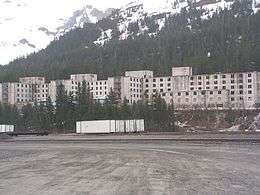Buckner Building
The Buckner Building is an abandoned former U.S. military building in Whittier, Alaska, on the Western edge of the Prince William Sound.[1]
| Buckner Building | |
|---|---|
| Near Whittier, Alaska in United States | |
 The Buckner Building | |
 Buckner Building | |
| Coordinates | 60°46′28.58″N 148°40′30.47″W |
| Type | Military building |
| Length | 500 feet |
| Site history | |
| Built | 1953 |
| In use | 1966 |
History
During the early stages of World War II, General Simon Buckner commanded the defense of Alaska and was concerned they would be attacked by air.[1][2] To protect the troops, General Buckner recommended a facility that was independent of local power plant, bomb-proof, and that had sufficient storage spaces.[2] Whittier, Alaska was the perfect place to have this military base.
First, the bay area around Whittier, Alaska has deep-water ports that stay ice-free year round.[3] With Whittier being one of two all-weather railroad ports that supplied Anchorage with military necessities, it was important that it would stay functioning and safeguarded.[4] Second, the almost constant cloud coverage would protect the facility from air strikes.[5]
Annex
The Cold War triggered the United States Army Corps of Engineers to quickly build housing and recreational spaces for 1,000 soldiers moving to Whittier.[1][3] The Composite Bachelor Housing Service and Recreation Center, also known as the Buckner Building, was completed in 1953.[6] This combined building had a mess hall, sleeping quarters, movie theatre, bowling alley, small jail, and tunnels connecting the town of Whittier, Alaska.[7]
The building used to be one of the largest in Alaska, often being referred to as "the city under one roof".[8] The building is six stories tall, about 500 feet long by 50–150 feet wide and is approximately 275,000 square feet.[4] The building was cast in place by reinforced concrete on slate/ greywacke bedrock, 8,1.
Earthquake
In, 1964, Whittier, Alaska was hit by the 1964 Alaska earthquake that lasted about three minutes.[9] A total of 13 people died in Whittier and damages to Federal and privately owned land would cost over $5 million.[4] The Buckner Building was slightly damaged though it was minimized due to the foundation being on bedrock, as opposed to the majority of the town which rest on unconsolidated sediment and therefore received more damage.[9] The Buckner Building also runs northeast-southwest, oblique to the seismic motion, decreasing the effect of the earthquake on the building.[4] There was no structural damage to the building, and subsequent inspections found the building to be in good condition.[9]
Decline
The building continued to operate until 1966, at which point the military pulled out and the Port of Whittier was transferred to the General Services Administration.[1] After the military left, the ownership of the Buckner Building went through a handful of people.[10] At one point, it was owned by one Pete Zamarillo who wanted to turn it into the state prison. In 1972 it was purchased by the citizens of the new City of Whittier and soon fell into disrepair.[6][10] With the windows and doors missing, the elements began to take it over, water infiltrated, leaving the building in a constant state of freezing and thawing.[11]
In 2016 the building went into foreclosure and the city assumed ownership. There is now a fence around the building to keep trespassers out.[10] The Whittier Department of Public Works and Public Utilities have done some work. The city would like to maintain it to preserve history but the Alaska Department of Environmental Conservation recommends that the building be torn down.[11]
References
- "Shadow of abandoned Buckner Building looms over Whittier". Anchorage Daily News. Retrieved 2018-11-19.
- "Chapter IX: The Garrisoning of Alaska, 1939-41". history.army.mil. Retrieved 2018-11-19.
- "Whittier History". Alaska.org. Retrieved 2018-11-19.
- Kachadoorian, Reuben (1965), "Effects of the earthquake of March 27, 1964, at Whittier, Alaska", U.S. Geological Survey Professional Paper (542–B), archived from the original on 17 Oct 2012
- "Whittier Alaska : Reed Young". www.reedyoung.com. Retrieved 2018-11-19.
- "DEC's Brownfield Assessment and Cleanup Projects". dec.alaska.gov. Retrieved 2018-11-19.
- Earthquake, National Research Council (U S. ) Committee on the Alaska (1968). The Great Alaska Earthquake of 1964. National Academies.
- Reitter, Bart (2011). The Horseman: A Travel Memoir. iUniverse. p. 99. ISBN 9781450292320.
- The Great Alaska Earthquake of 1964, Part 1. Washington D.C.: National Research Council (U.S.). Committee on the Alaska Earthquake. 1973. pp. 1077–1082.
- "In isolated Whittier, officials crack down on Buckner Building trespassers". Anchorage Daily News. Retrieved 2018-11-19.
- Alaska Department of Environmental Conservation (27 January 2016). "Structural Assessment for Remedial Design The Buckner Building" (PDF). Coffman Engineers.